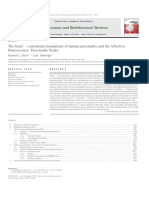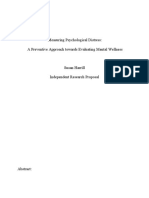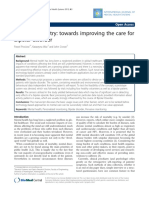0 ratings0% found this document useful (0 votes)
5 viewsSeminar
Seminar
Uploaded by
Sarthak VarshneyHeart Rate Variability
Copyright:
© All Rights Reserved
Available Formats
Download as PPTX, PDF, TXT or read online from Scribd
Seminar
Seminar
Uploaded by
Sarthak Varshney0 ratings0% found this document useful (0 votes)
5 views10 pagesHeart Rate Variability
Original Title
Seminar PPT
Copyright
© © All Rights Reserved
Available Formats
PPTX, PDF, TXT or read online from Scribd
Share this document
Did you find this document useful?
Is this content inappropriate?
Heart Rate Variability
Copyright:
© All Rights Reserved
Available Formats
Download as PPTX, PDF, TXT or read online from Scribd
Download as pptx, pdf, or txt
0 ratings0% found this document useful (0 votes)
5 views10 pagesSeminar
Seminar
Uploaded by
Sarthak VarshneyHeart Rate Variability
Copyright:
© All Rights Reserved
Available Formats
Download as PPTX, PDF, TXT or read online from Scribd
Download as pptx, pdf, or txt
You are on page 1of 10
TRACKING PULSE DYNAMICS TO CLASSIFY EMOTIONAL STRESS
LEVELS
VII SEMESTER
SEMINAR (ETEC-457)
Presented by: Mentored by:
Sarthak Varshney Dr. Jyoti Gupta
21711502820
What is Stress?
A biological response to physical or emotional stimuli that causes bodily or
mental tension and is a factor in disease causation[2].
Approximately 284 million people worldwide have mental disorders
emanating from stress.[1]
Burnout affects 76% of employees at least occasionally[3].
Worldwide estimated 1 million workers are absent every day because of
stress[1].
Monitoring stress provides crucial insights, aiding proactive stress
management.
Early Detection empowers individuals to address stress before it impacts
well-being.
2 Department of Electronics and Communication Engi
neering, BVCOE New Delhi
Types of Stress
Acute Stress
Immediate response to a specific event
Short-term & often intense.
Chronic Stress
Prolonged exposure to stressors.
Persistent, continuous pressure.
Episodic Acute Stress
Frequent occurrence of acute stress.
Tendency to “overreact” to situations.
Categories of Stressors:
• Physical
• Emotional
• Environmental
• Social
3 Department of Electronics and Communication Engi
neering, BVCOE New Delhi
The Stress-Heart Rate Connection
Basics of Heart Rate :
Heart rate is the number of heartbeats per minute (bpm).
Controlled by the autonomic nervous system.
Relation to Stress:
Stress triggers the "fight or flight" response.
Autonomic Nervous System affects heart rate: sympathetic (increase)
and parasympathetic (decrease).
Monitoring Pulse Dynamics:
Pulse reflects changes in emotional states.
Increased heart rate during stress indicates physiological arousal.
Significance
Understanding pulse dynamics aids in recognizing and managing stress.
Provides real-time insights into emotional well-being.
4 Department of Electronics and Communication Engi
neering, BVCOE New Delhi
Impact of Stress on Health
Physical Impacts:
Increased risk of cardiovascular diseases.
Weakened immune system, leading to frequent illnesses.
Elevated blood pressure and potential long-term health issues.
Mental Impacts
Greater susceptibility to anxiety and depression.
Impaired cognitive function and decision-making.
Disruption of sleep patterns, contributing to fatigue.
Behavioural Impacts
Adoption of unhealthy coping mechanisms (e.g., smoking, overeating).
Increased likelihood of substance abuse.
Impaired social interactions and relationships.
5 Department of Electronics and Communication Engi July 31, 2024
neering, BVCOE New Delhi
Importance of Early Detection
Early Warning Signs
Recognizing subtle cues before stress escalates.
Identifying changes in behaviour, sleep patterns, and emotional well-being.
Prevention vs. Intervention
Proactive stress management for overall well-being.
Timely interventions to prevent chronic stress-related health issues.
6 Department of Electronics and Communication Engi July 31, 2024
neering, BVCOE New Delhi
Technology In Stress Monitoring
Wearable Devices
Smartwatches and fitness trackers offer continuous heart rate monitoring.
Track trends over time, providing valuable insights into stress patterns.
Pulse Oximeters
Measure oxygen levels in the blood, reflecting physiological stress.
Useful for assessing respiratory response during stressful situations.
Mobile Apps:
Stress tracking applications utilize heart rate data for real-time analysis.
Provide users with actionable feedback and stress management tools.
Integration Potential:
Increasing connectivity between devices for comprehensive stress monitoring.
Enables a holistic approach to mental well-being through various data sources.
7 Department of Electronics and Communication Engi July 31, 2024
neering, BVCOE New Delhi
Pulse Dynamics As an Emotional Indicator
Research: Studies link heart rate patterns to emotions.
Real-time Tracking: Wearables provide instant insights.
Visual Representation: Graphs show emotional states.
Applications: Inform personalized stress interventions.
Takeaway: Pulse dynamics enable proactive mental health care.
8 Department of Electronics and Communication Engi July 31, 2024
neering, BVCOE New Delhi
References
1. World Health Organisation, World employment and social outlook report, 2022.
2. Depression and Mental Health, American Psychological Association, 2019
3. SingleCare Checkup: How common is stress and who’s most affected, 2023
4. Shajari, Shaghayegh & Salahandish, Razieh & Zare. (2022). MicroSweat: A
Wearable Microfluidic Patch for Noninvasive and Reliable Sweat Collection
Enables Human Stress Monitoring. Advanced Science. 10.
10.1002/advs.202204171.
5. Iqbal, Talha & Simpkin, Andrew & Roshan. (2022). Stress Monitoring Using
Wearable Sensors: A Pilot Study and Stress-Predict Dataset. Sensors.
9 Department of Electronics and Communication Engi
neering, BVCOE New Delhi
THANK YOU!
10 Department of Electronics and Communication Engi
neering, BVCOE New Delhi
You might also like
- Stop OverthinkingDocument75 pagesStop OverthinkingMark anthony Palabay50% (2)
- What Fantasies Can Do To Your RelationshipDocument16 pagesWhat Fantasies Can Do To Your RelationshipNecamaNo ratings yet
- Psych 155 Case StudyDocument2 pagesPsych 155 Case Studycoleenllb_usa100% (1)
- Resistance and GestaltDocument9 pagesResistance and GestaltAdriana Bogdanovska Toskic100% (1)
- Davis & Panksepp (2011) - ANPSDocument14 pagesDavis & Panksepp (2011) - ANPSFrancisco RodriguesNo ratings yet
- A Survey of Affective Computing For Stress DetectionDocument13 pagesA Survey of Affective Computing For Stress Detectionegle.klekereNo ratings yet
- The Feasibility of Wearable and Self-Report Stress Detection Measures in A Semi-Controlled Lab EnvironmentDocument16 pagesThe Feasibility of Wearable and Self-Report Stress Detection Measures in A Semi-Controlled Lab Environmentnehatabassum4237No ratings yet
- Paper Isda 2010 CairoDocument5 pagesPaper Isda 2010 Cairosupport6486No ratings yet
- 2017 - SPRINGER - Emhealth Towards Emotion Health Through Depression Prediction and Intelligent Health Recommender SystemDocument11 pages2017 - SPRINGER - Emhealth Towards Emotion Health Through Depression Prediction and Intelligent Health Recommender SystemPriya KumariNo ratings yet
- Mindfulness For Stress Reduction MDocument16 pagesMindfulness For Stress Reduction Mapi-557851251No ratings yet
- Seungjae-Lee2020 HRVDocument16 pagesSeungjae-Lee2020 HRVanh22112001No ratings yet
- Mind-Body Internet and Mobile-Based Interventions For Depression and AnxietyDocument27 pagesMind-Body Internet and Mobile-Based Interventions For Depression and AnxietyLuciana VieiraNo ratings yet
- Fin Irjmets1681152119Document9 pagesFin Irjmets1681152119Kishore Kanna Ravi KumarNo ratings yet
- Aspek Psikososial, Kultural Dan Spiritual Klien Hiv Aids: Kelompok IDocument21 pagesAspek Psikososial, Kultural Dan Spiritual Klien Hiv Aids: Kelompok Idhila belkiNo ratings yet
- Articulo 02Document6 pagesArticulo 02Cinthya C. Acevedo JiménezNo ratings yet
- Physical Activity and Prevention of Mental HealthDocument10 pagesPhysical Activity and Prevention of Mental Healthtaiane ferreiraNo ratings yet
- Inter Reality in The Treatment of Psychological Stress in Soldiers - Rationale and Protocol of The Inter Stress ProjectDocument13 pagesInter Reality in The Treatment of Psychological Stress in Soldiers - Rationale and Protocol of The Inter Stress Projectsupport6486No ratings yet
- A Study To Evaluate The Effectiveness of Guided Imagery Technique On Stress Among Hypertensive Patients in Selected Rural Areas of Kodaikanal Taluk, TamilnaduDocument3 pagesA Study To Evaluate The Effectiveness of Guided Imagery Technique On Stress Among Hypertensive Patients in Selected Rural Areas of Kodaikanal Taluk, TamilnaduIjsrnet EditorialNo ratings yet
- IntroductionDocument4 pagesIntroductionMd Sherajul HaqueNo ratings yet
- (IJCST-V10I3P31) :maria Ashigha, Rasha Shajahan, Shifana Abdul Azeez, Kashish S Shah, Veena K ViswamDocument8 pages(IJCST-V10I3P31) :maria Ashigha, Rasha Shajahan, Shifana Abdul Azeez, Kashish S Shah, Veena K ViswamEighthSenseGroupNo ratings yet
- Complementary Therapies in Clinical PracticeDocument11 pagesComplementary Therapies in Clinical PracticeSeva Ikhsan PambudiNo ratings yet
- alabdi2018-2Document14 pagesalabdi2018-2Juan PabloNo ratings yet
- D5 ExecDocument5 pagesD5 ExecJhon Michael FerrerNo ratings yet
- Deep LearningDocument42 pagesDeep Learningbinte tariqNo ratings yet
- More Than A Feeling A Unified View of ST PDFDocument24 pagesMore Than A Feeling A Unified View of ST PDFmarcelocarvalhoteacher2373No ratings yet
- 2018 - NATURE - Automatic Detection of Major Depressive Disorder Using Electrodermal ActivityDocument9 pages2018 - NATURE - Automatic Detection of Major Depressive Disorder Using Electrodermal ActivityPriya KumariNo ratings yet
- 1757-448X-21-1-020Document11 pages1757-448X-21-1-020vireshghugareNo ratings yet
- Gedam 2020Document7 pagesGedam 2020Nguyễn Xuân ThànhNo ratings yet
- Bakker Hacdais2011Document8 pagesBakker Hacdais2011fenix93No ratings yet
- Stress Management and Coping StrategiesDocument89 pagesStress Management and Coping StrategiesIqra GhoriNo ratings yet
- base_paper (1)Document14 pagesbase_paper (1)vireshghugareNo ratings yet
- Journal of Psychosomatic ResearchDocument17 pagesJournal of Psychosomatic ResearchBachril IlmiNo ratings yet
- 1 s2.0 S0169260721003886 MainDocument14 pages1 s2.0 S0169260721003886 MainNguyễn Xuân ThànhNo ratings yet
- A Practitioner's Guide To BreathworkDocument18 pagesA Practitioner's Guide To BreathworkOctavio Uriel Garrido Lopez100% (1)
- Energy Wahout a New Method to Achieve Wellbeing and HealthDocument9 pagesEnergy Wahout a New Method to Achieve Wellbeing and HealthScivision PublishersNo ratings yet
- Exercise and The Prevention of DepressionDocument9 pagesExercise and The Prevention of DepressionEdlene HoffmannNo ratings yet
- Ijerph 20 05319Document12 pagesIjerph 20 05319Yasmin BernardoNo ratings yet
- Examining Factors For Anxiety and Depression PredictionDocument10 pagesExamining Factors For Anxiety and Depression Predictionsakshigourab.14No ratings yet
- SynopsisDocument12 pagesSynopsiskavya J.CNo ratings yet
- ODIDocument8 pagesODIdave.vass.xiiiNo ratings yet
- Measuring Psychological Distress 5Document32 pagesMeasuring Psychological Distress 5api-548101002No ratings yet
- Eggart 2020Document11 pagesEggart 2020Rikus OfAthasNo ratings yet
- tmpF7A9 TMPDocument2 pagestmpF7A9 TMPFrontiersNo ratings yet
- Unit 9Document9 pagesUnit 9pooja singhNo ratings yet
- Bachelor of Technology Information Technology BY Y. Varun - 20R91A1248 I. Kavya - 20R91A1221 N. Sunil - 20R91A1228Document83 pagesBachelor of Technology Information Technology BY Y. Varun - 20R91A1248 I. Kavya - 20R91A1221 N. Sunil - 20R91A1228harathigaganganmoniNo ratings yet
- Impacts of StressDocument7 pagesImpacts of StressMovie CentralNo ratings yet
- Recommendations For Monitoring and Reporting Harm in Mindfulness For Psychosis ResearchDocument3 pagesRecommendations For Monitoring and Reporting Harm in Mindfulness For Psychosis ResearchOrion OriNo ratings yet
- BÀI 1Document23 pagesBÀI 1Trọng MườiNo ratings yet
- European Psychiatry: Katarina Krkovic, Stephanie Krink, Tania M. LincolnDocument7 pagesEuropean Psychiatry: Katarina Krkovic, Stephanie Krink, Tania M. LincolnGreentea LatteNo ratings yet
- Peerj 4598Document27 pagesPeerj 4598David QatamadzeNo ratings yet
- Topical Review ArticleDocument12 pagesTopical Review ArticleadnanjivrakNo ratings yet
- Fundamental Mechanism of Organ Diseases A New Theory Connecting The Stress Reaction and Type of Disease 1047Document7 pagesFundamental Mechanism of Organ Diseases A New Theory Connecting The Stress Reaction and Type of Disease 1047JOUBAANo ratings yet
- Stress, Emotions and Health - The Manual for Integrative ProfessionalsFrom EverandStress, Emotions and Health - The Manual for Integrative ProfessionalsNo ratings yet
- Covid 19 and Its Potential Stressful EffDocument8 pagesCovid 19 and Its Potential Stressful EffAurora FelixNo ratings yet
- Salivary Biomarkers of Stress, Anxiety and DepressionDocument12 pagesSalivary Biomarkers of Stress, Anxiety and DepressionJuan Camilo Benitez AgudeloNo ratings yet
- DepXGBoot: Depression Detection Using A Robust Tuned Extreme Gradient Boosting Model GeneratorDocument12 pagesDepXGBoot: Depression Detection Using A Robust Tuned Extreme Gradient Boosting Model GeneratorIAES IJAINo ratings yet
- Emotional HealthDocument66 pagesEmotional Healthraghudesai951No ratings yet
- Effects of Exercise On Anxiety and Depression Disorders: Review of Meta-Analyses and Neurobiological MechanismsDocument13 pagesEffects of Exercise On Anxiety and Depression Disorders: Review of Meta-Analyses and Neurobiological MechanismsRomeo IsaíasNo ratings yet
- 2021 - Associations of Physical Activity, Sedentary Behaviour, and Physical Fitness With Common Mental Health Symptoms in The PopulationDocument216 pages2021 - Associations of Physical Activity, Sedentary Behaviour, and Physical Fitness With Common Mental Health Symptoms in The PopulationIvan TertulianoNo ratings yet
- App Based Delivery of Clinical EmotionalDocument16 pagesApp Based Delivery of Clinical EmotionalJosyNo ratings yet
- Anxiety and Resistance Training PDFDocument12 pagesAnxiety and Resistance Training PDFPaulo AfonsoNo ratings yet
- Facial ExpDocument9 pagesFacial ExpKore Joy PrincyNo ratings yet
- Mobile Psychiatry: Towards Improving The Care For Bipolar DisorderDocument10 pagesMobile Psychiatry: Towards Improving The Care For Bipolar DisorderGustavoNo ratings yet
- Final Draft - Jaelah MarshallDocument15 pagesFinal Draft - Jaelah Marshallapi-742054215No ratings yet
- Exercise and The Prevention of Depression: Results of The HUNT Cohort StudyDocument9 pagesExercise and The Prevention of Depression: Results of The HUNT Cohort StudyLydia AmaliaNo ratings yet
- Transference and Counter TransferenceDocument10 pagesTransference and Counter TransferenceSajal SahooNo ratings yet
- Grade7 Q3 Test Tos and Answer KeyDocument7 pagesGrade7 Q3 Test Tos and Answer KeyRonelle San buenaventuraNo ratings yet
- ABPG1103Document244 pagesABPG1103nadiaNo ratings yet
- VH IO WellbeingDocument2 pagesVH IO WellbeingNadine BalNo ratings yet
- Empathic AbilitiesDocument8 pagesEmpathic AbilitiesJulie SmithNo ratings yet
- Personal Development Grade 12 Family LegaciesDocument26 pagesPersonal Development Grade 12 Family LegaciesqkarlyleannNo ratings yet
- A Client's Guide To Schema-Focused Cognitive TherapyDocument7 pagesA Client's Guide To Schema-Focused Cognitive TherapyPatricia100% (4)
- UnderselfDocument10 pagesUnderselfThea CanlasNo ratings yet
- Paper 1 Full OutlineDocument7 pagesPaper 1 Full OutlineRonak BhattNo ratings yet
- Individuality Embodiment and The Anchoring of A Higher Frequency - B. GuentherDocument96 pagesIndividuality Embodiment and The Anchoring of A Higher Frequency - B. GuentherGeetika CnNo ratings yet
- Theories On Motivation & Goal SettingDocument26 pagesTheories On Motivation & Goal SettingshrikantgakhareNo ratings yet
- How To The Arts Help Us Understand The WorldDocument2 pagesHow To The Arts Help Us Understand The WorldЭ. АнукаNo ratings yet
- Emotional Intelligence at The Workplace-Ing MRS Alberta AmankwaaDocument40 pagesEmotional Intelligence at The Workplace-Ing MRS Alberta AmankwaaJohn SuleNo ratings yet
- IMPACT OF STRESS ON ACADEMIC PERFORMANCE AND SELF ESTEEM (1) DoneDocument39 pagesIMPACT OF STRESS ON ACADEMIC PERFORMANCE AND SELF ESTEEM (1) DoneANKIT SINGH RAWATNo ratings yet
- The Shadow From A Buddhist PerspectiveDocument14 pagesThe Shadow From A Buddhist PerspectiveGuilherme Simão100% (1)
- Skin Response Meter Viva QuestionsDocument7 pagesSkin Response Meter Viva QuestionssaurabhdabasNo ratings yet
- Geriatric AssessmentDocument51 pagesGeriatric AssessmentJustine Plaza100% (2)
- The Biochemistry of Belief: T.S. Sathyanarayana Rao, M. R. Asha, K. S. Jagannatha Rao, P. VasudevarajuDocument3 pagesThe Biochemistry of Belief: T.S. Sathyanarayana Rao, M. R. Asha, K. S. Jagannatha Rao, P. VasudevarajuRoxana HagyNo ratings yet
- ClassX IT Self-Management Emp SkillsDocument10 pagesClassX IT Self-Management Emp SkillsSuryanshuNo ratings yet
- Mo PDFDocument6 pagesMo PDFMykii TagotiNo ratings yet
- Beck Depression InventoryDocument6 pagesBeck Depression Inventorywsergio0072100% (3)
- Anger Management PDFDocument20 pagesAnger Management PDFGohar YaseenNo ratings yet
- Emotion BrochureDocument3 pagesEmotion BrochureDORRAINE BENNETTNo ratings yet
- LSE Kalpana ChhetriDocument7 pagesLSE Kalpana ChhetriAdhya DubeyNo ratings yet
- Neopi3 ScalesDocument1 pageNeopi3 ScalesMatt UteNo ratings yet

























































































